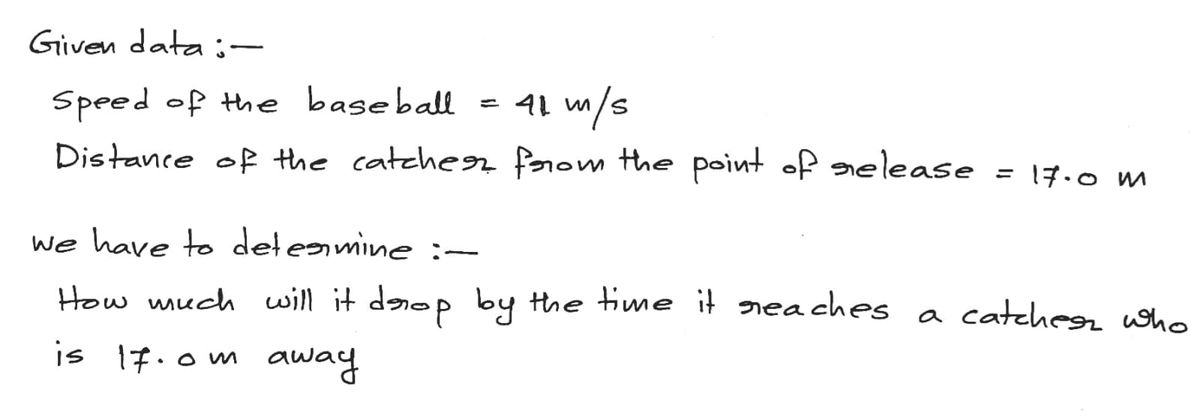29. A major-league pitcher can throw a baseball in excess of 41.0 m/s. If a ball is thrown horizontally at this speed, how much will it drop by the time it reaches a catcher who is 17.0 m away from the point of release?
29. A major-league pitcher can throw a baseball in excess of 41.0 m/s. If a ball is thrown horizontally at this speed, how much will it drop by the time it reaches a catcher who is 17.0 m away from the point of release?
College Physics
11th Edition
ISBN:9781305952300
Author:Raymond A. Serway, Chris Vuille
Publisher:Raymond A. Serway, Chris Vuille
Chapter1: Units, Trigonometry. And Vectors
Section: Chapter Questions
Problem 1CQ: Estimate the order of magnitude of the length, in meters, of each of the following; (a) a mouse, (b)...
Related questions
Concept explainers
Topic Video
Question
Ch.3 #29 . Please see attached image for Physics question . Thank you

Transcribed Image Text:**Problem Statement:**
A major-league pitcher can throw a baseball in excess of 41.0 m/s. If a ball is thrown horizontally at this speed, how much will it drop by the time it reaches a catcher who is 17.0 m away from the point of release?
**Explanation:**
This problem involves understanding the physics of projectile motion in the absence of air resistance. When a baseball is thrown horizontally, the only force acting on it vertically is gravity, which causes it to drop over time.
To find the vertical drop of the baseball, we'll use the following formula for vertical motion under constant acceleration due to gravity (g = 9.81 m/s²):
1. **Time of flight, t:**
\( t = \frac{\text{horizontal distance}}{\text{horizontal speed}} \)
\( t = \frac{17.0 \, \text{m}}{41.0 \, \text{m/s}} \)
2. **Vertical drop, y:**
\( y = \frac{1}{2} g t^2 \)
After calculating t, substitute it into this equation to find the drop.
Expert Solution
Step 1

Step by step
Solved in 2 steps with 2 images

Knowledge Booster
Learn more about
Need a deep-dive on the concept behind this application? Look no further. Learn more about this topic, physics and related others by exploring similar questions and additional content below.Recommended textbooks for you

College Physics
Physics
ISBN:
9781305952300
Author:
Raymond A. Serway, Chris Vuille
Publisher:
Cengage Learning

University Physics (14th Edition)
Physics
ISBN:
9780133969290
Author:
Hugh D. Young, Roger A. Freedman
Publisher:
PEARSON

Introduction To Quantum Mechanics
Physics
ISBN:
9781107189638
Author:
Griffiths, David J., Schroeter, Darrell F.
Publisher:
Cambridge University Press

College Physics
Physics
ISBN:
9781305952300
Author:
Raymond A. Serway, Chris Vuille
Publisher:
Cengage Learning

University Physics (14th Edition)
Physics
ISBN:
9780133969290
Author:
Hugh D. Young, Roger A. Freedman
Publisher:
PEARSON

Introduction To Quantum Mechanics
Physics
ISBN:
9781107189638
Author:
Griffiths, David J., Schroeter, Darrell F.
Publisher:
Cambridge University Press

Physics for Scientists and Engineers
Physics
ISBN:
9781337553278
Author:
Raymond A. Serway, John W. Jewett
Publisher:
Cengage Learning

Lecture- Tutorials for Introductory Astronomy
Physics
ISBN:
9780321820464
Author:
Edward E. Prather, Tim P. Slater, Jeff P. Adams, Gina Brissenden
Publisher:
Addison-Wesley

College Physics: A Strategic Approach (4th Editio…
Physics
ISBN:
9780134609034
Author:
Randall D. Knight (Professor Emeritus), Brian Jones, Stuart Field
Publisher:
PEARSON